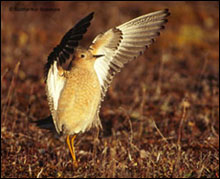Sun-drenched Pelican Island in Florida is about as far from the Arctic National Wildlife Refuge as you can get in the United States. At first blush, the 5,000-acre warm marsh would seem to have little connection to the 19 million-acre stretch of mountains and tundra. But they are inextricably linked.
A buff-breasted sandpiper.
© Subhankar Banerjee, from his book Arctic National Wildlife Refuge: Seasons of Life and Land.
As part of the National Wildlife Refuge System, both places provide migratory birds with habitat and sustain valuable wetlands. Both play historic roles in the development of refuge-based conservation. And both help maintain the natural integrity of our continent’s ecosystems.
In the controversy over whether petroleum development in the Arctic Refuge is worth the threat to habitat and wilderness, a crucial broader issue has been lost: how will drilling and development affect the 95 million-acre refuge system? Last month’s Senate vote to open the Arctic Refuge to drilling puts the already-patchy network in danger of unraveling — and it defies a protective statute Congress ... Read more
